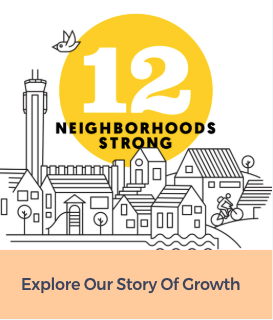SUSTAINABILITY
GOOD THINGS LAST.
The Central Park community has always been envisioned as a place where people, commerce and the natural environment could live in harmony. These days, they call that being “green” or “sustainable.” And it translates into some real benefits: less greenhouse gas released into the air; a healthier environment for your children and their children; and more dollars in your pocket. But we call it being smart.
During the worst of the economic recession, Central Park (at that time Stapeton) ranked as the top-selling, new-home community in metro Denver, with resale homes more than holding their own in a down market. It’s a vote of confidence. The ultimate indicator of smart, sustainable design – and lasting value.
RECYCLING
Nearly 90% of the community’s households participate in Denver’s voluntary recycling program. Even our waste doesn’t go to waste. Recycling is sustainable at its best.
ZERO ENERGY READY HOMES
The department of Energy’s Zero Energy Ready Home is a high-performance home so efficient that a renewable system (i.e. solar) can offset all or most of its annual energy consumption. Learn more about Zero Energy Ready Homes.
NET-ZERO ENERGY HOMES
Thrive Home Builders’ Vitality collection features an unprecedented Zero Energy Option, which means your home is working for you – producing as much energy as you consume. Saving energy and generating it so you can live more comfortably. Learn more about Thrive Home Builder’s Net-Zero Energy Homes.
ENERGY STAR 3.0
In Denver’s 80238, we’re always upping the ante on energy-efficiency. Our newest homes will meet or surpass the latest ENERGY STAR 3.0 standards. Meaning all our homes use much less energy.
HERS SCORES
The Home Energy Rating System (HERS) is an independently tested industry standard for measuring each home’s energy performance. The lower your home’s rating – the smaller your energy footprint. And the lower your energy costs. You’ll be happy to know that Central Park touts some of the lowest HERS scores in Denver. In fact, on average – new homes are about 40% more efficient than other new homes simply built to code. Ask your builder about their HERS scores.
REAL-TIME ENERGY FEEDBACK
In our next-generation homes, a high-tech display, or dashboard, lets you monitor your energy use in real- time. Which could help you find ways to save a little more.
LEED CERTIFICATION
Much of Central Park’s retail and office space is LEED-certified, which reduces operating costs, improves indoor air quality and promotes productivity, in addition to being more sustainable.
HELP FROM THE TREES
When it comes to minimizing greenhouse gases and maximizing neighborhood beauty, nothing beats a tree. That’s why we’ve planted more than 39,000 throughout the 12 neighborhoods.
NATURE NEARBY
Central Park has 60+ Denver parks including 80-acre Central Park and more on the way. In fact, approximately a third of the community is dedicated to recreational open space for Denver and surrounding communities.
GIVING WATER BACK TO THE LAND
We transformed Westerly Creek from a buried drainpipe into an ecological showcase: part recreational park, part riparian ecosystem, part storm water management system. All good and the essence of sustainability.
WATER CONSERVATION
Our water-saving methods range from drought-tolerant landscaping in yards and public spaces to low-flow toilets and showerheads. Saving water sustains us for future generations.
COMMUTER RAIL (TRANSIT-ORIENTED)
Opened in April, 2016, Central Park Station Commuter Rail Stop provides even faster transport to Downtown Denver and DIA! It will help save gas, lower carbon emissions, reduce traffic congestion and simplify life – all in one fell swoop (whatever that means).
HOMES WITH FIBER
Sustainability means being future-proof. Every new home in the neighborhoods north of I-70 will be tied into a robust fiber optic network to keep up with the ever-growing technology demands.
WALKABILITY (& BIKE-ABILITY)
Every amenity you need – shopping, dining, schools, entertainment – is nearby, minimizing the need to get in a car. Burning calories instead of gas is a good thing.
PUBLIC TRANSPORTATION
Central Park has 11 RTD bus routes that directly serve the Transit Center, located at 36th Avenue and Central Park Boulevard. This public transportation hub is connected to more than 10,000 RTD bus stops across eight counties in the Denver metro area. For example, you can take the 89 bus route to Anschutz Medical Campus, or the 73 and 15L routes to the Denver Art Museum.



